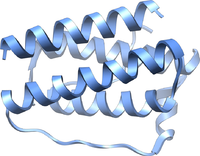
Photo from wikipedia
Caloric restriction (CR) can attenuate the general loss of health observed during aging, being one of the mechanisms involved the reduction of hormonal alteration, such as insulin and leptin. This… Click to show full abstract
Caloric restriction (CR) can attenuate the general loss of health observed during aging, being one of the mechanisms involved the reduction of hormonal alteration, such as insulin and leptin. This change could also prevent age-specific fluctuations in brain monoamines, although few studies have addressed the effects of CR on peripheral hormones and central neurotransmitters exhaustively. Therefore, the variations in brain monoamine levels and some peripheral hormones were assessed here in adult 4-month old and 24-month old male Wistar rats fed ad libitum (AL) or maintained on a 30% CR diet from four months of age. Noradrenaline (NA), dopamine (DA), serotonin (5-HT) and its metabolites were measured by high-performance liquid chromatography with electrochemical detection (HPLC-ED) in nine brain regions: cerebellum, pons, midbrain, hypothalamus, thalamus, hippocampus, striatum, frontal cortex, and occipital cortex. In addition, the blood plasma levels of hormones like corticosterone, insulin and leptin were also evaluated, as were insulin-like growth factor 1 and other basal metabolic parameters using enzyme-linked immunosorbent assays (ELISAs): cholesterol, glucose, triglycerides, albumin, low-density lipoprotein, calcium and high-density lipoprotein (HDLc). CR was seen to increase the NA levels that are altered by aging in specific brain regions like the striatum, thalamus, cerebellum and hypothalamus, and the DA levels in the striatum, as well as modifying the 5-HT levels in the striatum, hypothalamus, pons and hippocampus. Moreover, the insulin, leptin, calcium and HDLc levels in the blood were restored in old animals maintained on a CR diet. These results suggest that a dietary intervention like CR may have beneficial health effects, recovering some negative effects on peripheral hormones, metabolic parameters and brain monoamine concentrations.
Journal Title: Scientific Reports
Year Published: 2020
Link to full text (if available)
Share on Social Media: Sign Up to like & get
recommendations!